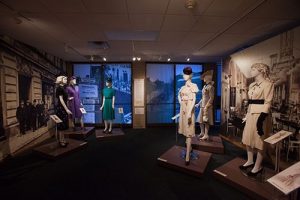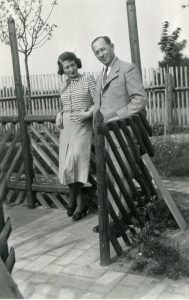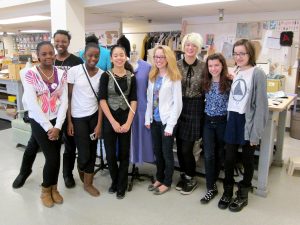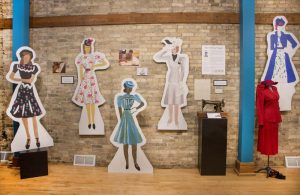by Amanda Miano
“Paul and Hedy Strnad are trapped as the Nazis close in. Can Hedy’s dress designs and their cousin in Milwaukee help them get to the United States? All efforts failed. Hedy and Paul perished in the Holocaust, but their memory lives on in the letter and sketches which form the core of this haunting exhibit. Come and experience Hedy’s designs brought to life” (Stitching History from the Holocaust).
“Stitching History from the Holocaust,” was an exhibit on display from September 14, 2014 to March 1, 2015 at the Jewish Museum Milwaukee and is  currently touring across the United States. For this unique exhibit, the Jewish Museum Milwaukee partnered with the Milwaukee Repertory Theater to create dresses based on Hedy Strnad’s designs. The museum’s goal was to do more than present Hedy and Paul’s story. Rather, “. . . completing this project for [Hedy was] a meaningful act of memorialization, as it [brought] Hedy’s talent and creativity into the current day” (UW-Milwaukee Digital Humanities Lab).
currently touring across the United States. For this unique exhibit, the Jewish Museum Milwaukee partnered with the Milwaukee Repertory Theater to create dresses based on Hedy Strnad’s designs. The museum’s goal was to do more than present Hedy and Paul’s story. Rather, “. . . completing this project for [Hedy was] a meaningful act of memorialization, as it [brought] Hedy’s talent and creativity into the current day” (UW-Milwaukee Digital Humanities Lab).
It is important, when considering the impact of this exhibit and how it promotes the museum’s vision, to understand the Jewish Museum Milwaukee’s mission statement which reads as follows: “The Jewish Museum Milwaukee is dedicated to preserving and presenting the history of the Jewish people in southeastern Wisconsin and celebrating the continuum of Jewish heritage and culture. . .” (About). To fully understand how this exhibit complements the museum’s overall mission, we need to take a closer look at the Strnad’s story.
Paul Strnad wrote a letter in 1939 to his cousin, asking for help in securing an  affidavit, necessary for he and his wife to escape Nazi-occupied Czechoslovakia. Paul also sent eight of Hedy’s dress designs, as a way of proving that the couple could secure an income if they were allowed to immigrate. Sadly, the couple were imprisoned before they could secure safe passage and were eventually murdered in a concentration camp. The letter and sketches were not discovered until 1997, when the Strnad’s of Wisconsin found them in the basement of their family home. They donated the documents to the Jewish Historical Society in Milwaukee. These items became part of the Jewish Museum Milwaukee’s permanent collection when it opened in 2008.
affidavit, necessary for he and his wife to escape Nazi-occupied Czechoslovakia. Paul also sent eight of Hedy’s dress designs, as a way of proving that the couple could secure an income if they were allowed to immigrate. Sadly, the couple were imprisoned before they could secure safe passage and were eventually murdered in a concentration camp. The letter and sketches were not discovered until 1997, when the Strnad’s of Wisconsin found them in the basement of their family home. They donated the documents to the Jewish Historical Society in Milwaukee. These items became part of the Jewish Museum Milwaukee’s permanent collection when it opened in 2008.
For a museum whose focus is on “. . . preserving and presenting the history of the Jewish people in southeastern Wisconsin and celebrating the continuum of Jewish heritage and culture . . .,” it is obvious why they would want to make people aware of this couple who sought refuge with their cousins from Wisconsin (About). Furthermore, this exhibit is dedicated to celebrating the continuum of Jewish culture, in that it presents the artistic abilities of one Jewish woman who should have lived to see her creations take form.
Now it is time to consider how this exhibit has aided the museum in promoting advocacy and outreach within the larger Milwaukee community. Using the  dresses as sources of inspiration, the Jewish Museum Milwaukee partnered with Arts@Large, a local arts education organization, and with Milwaukee Public Schools to allow a select group of 7th and 8th grade girls to take a behind the scenes look at the work that goes into costume designing. The eight girls who were chosen spent time with the staff of the Rep’s Costume Shop, where they learned more about Hedy’s dress designs and the hard work that went into designing and crafting these dresses. The girls were tasked with documenting their experience through photography and then, as a way of
dresses as sources of inspiration, the Jewish Museum Milwaukee partnered with Arts@Large, a local arts education organization, and with Milwaukee Public Schools to allow a select group of 7th and 8th grade girls to take a behind the scenes look at the work that goes into costume designing. The eight girls who were chosen spent time with the staff of the Rep’s Costume Shop, where they learned more about Hedy’s dress designs and the hard work that went into designing and crafting these dresses. The girls were tasked with documenting their experience through photography and then, as a way of  reflecting on all that they had learned, they were instructed to paint life-size self-portraits based on Hedy Strnad’s sketches. By allowing the girls this opportunity, the museum and Arts@Large not only gave them a space to showcase their own work (as each of their portraits were featured in an exhibition at the Arts@Large gallery), but also gave visitors the opportunity to see Hedy’s dresses worn by the next generation.
reflecting on all that they had learned, they were instructed to paint life-size self-portraits based on Hedy Strnad’s sketches. By allowing the girls this opportunity, the museum and Arts@Large not only gave them a space to showcase their own work (as each of their portraits were featured in an exhibition at the Arts@Large gallery), but also gave visitors the opportunity to see Hedy’s dresses worn by the next generation.
While Hedy Strnad never did get to see her dresses in all their beauty, her name will live on through her artistry. When they were fabricating her dresses, the Rep’s Costume Shop gave each piece a “Hedy Original” label, “. . . allowing her to posthumously have the fashion line taken from her by the Holocaust” (UW-Milwaukee Digital Humanities Lab). So, while the Nazis took her life, they could not erase her from the memories of those who, thanks to the Jewish Museum Milwaukee, have been able to view her beautiful creations at the “Stitching History from the Holocaust” exhibit.
